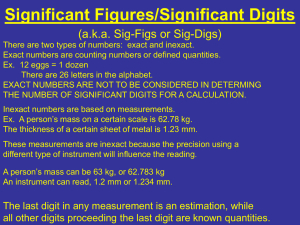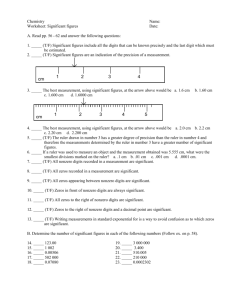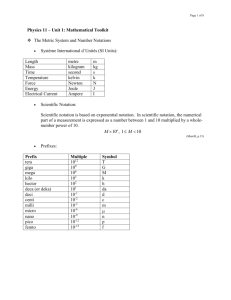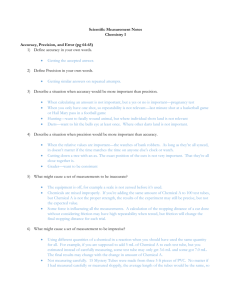Measurements & Uncertainty: Chemistry Presentation
advertisement
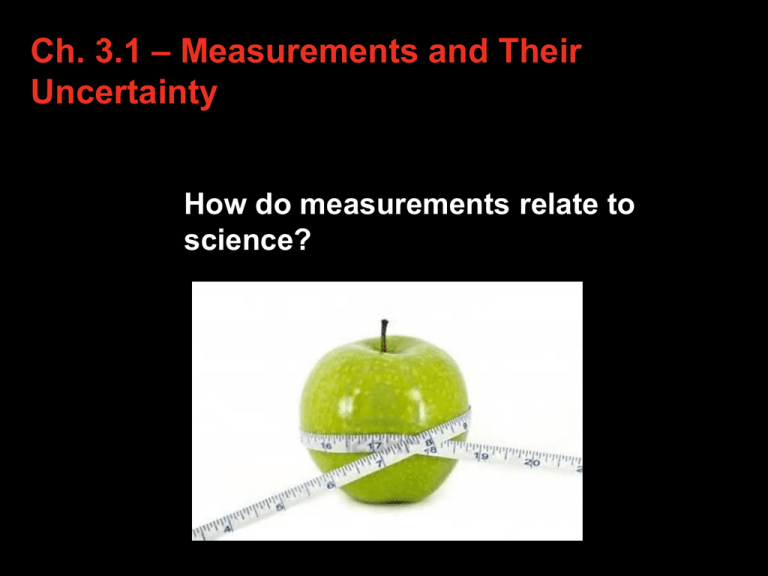
3.1 Ch. 3.1 – Measurements and Their Uncertainty How do measurements relate to science? 3.1 A measurement is a quantity that has both a number and a unit. Measurements are fundamental to the experimental sciences. Scientific Notation In Chemistry, we will use very LARGE and very small numbers to measure and count. E.g., 1 gram of hydrogen contains about 602,000,000,000,000,000,000 atoms of hydrogen – this can be written 6.02 X 1023atoms of hydrogen; and the mass of one atom of gold, 0.000 000 000 000 000 000 000 327g, can be written 3.27 X 10-22g. 3.1 Accuracy, Precision, and Error It is important to be able to make measurements and to decide whether a measurement is correct. How do you evaluate accuracy and precision? 3.1 Just because a measuring device works, you cannot assume it is accurate. The scale below has not been properly zeroed, so the reading obtained for the person’s weight is inaccurate. 3.1 Accuracy • Accuracy is a measure of how close a measurement comes to the actual or true value of whatever is measured. • To evaluate the accuracy of a measurement, the measured value must be compared to the correct value. 3.1 Determining Error • The accepted value is the correct value based on reliable references. • The experimental value is the value measured in the lab. • The difference between the experimental value and the accepted value is called the error. 3.1 The percent error is the absolute value of the error divided by the accepted value, multiplied by 100%. 3.1 3.1 Precision • Precision is a measure of how close a series of measurements are to one another. • To evaluate the precision of a measurement, you must compare the values of two or more repeated measurements. 3.1 Accuracy = amount by which a measurement deviates from true value - how well you've actually done in making the measurement Precision = how many decimal places (significant figures) can you determine through your measurement - how well you think that you've done in making the measurement Consider a ruler marked in cm vs. one marked in mm you can get a more precise measurement from the mm ruler but, if the ruler is marked incorrectly (say, the spacings between marks vary), your measurement cannot be accurate 3.1 Significant Figures in Measurements Why must measurements be reported to the correct number of significant figures? 3.1 The significant figures in a measurement include all of the digits that are known, plus a last digit that is estimated. 3.1 When is a digit in a measurement significant? All nonzero digits (24.7m, 0.743m, 714m) All zeros between nonzero digits (7003m, 40.79m, 1.503m) Placeholder zeros to the left of nonzero digits (0.0071m, 0.42m, 0.000099m) *Write using scientific notation Trailing zeros with a decimal point (43.00m,1.010m, 9.000m) Trailing zeros without a decimal point are just placeholders (300m, 7000m, 27,210m) *Write using scientific notation if zeros are significant There are two cases in which the significant figures are unlimited and therefore do not limit the precision of your calculations. o Counting in which you have an exact number (27 people in the room) o Defined quantities (60 min=1 hour, 100 cm = 1m) for Conceptual Problem 3.1 3.1 Significant Figures in Calculations How does the precision of a calculated answer compare to the precision of the measurements used to obtain it? 3.1 In general, a calculated answer cannot be more precise than the least precise measurement from which it was calculated. 3.1 Rounding The calculated value must be rounded to make it consistent with the precision of the measurements from which it was calculated. First decide how many sig figs your answer should have. The answer depends on the given measurements and on the mathematical process used to arrive at the answer. 3.1 for Sample Problem 3.1 3.1 Addition and Subtraction The answer to an addition or subtraction calculation should be rounded to the same number of decimal places (not digits) as the measurement with the least number of decimal places. 3.2 3.2 for Sample Problem 3.2 3.1 Multiplication and Division • In calculations involving multiplication and division, you need to round the answer to the same number of significant figures as the measurement with the least number of significant figures. • The position of the decimal point has nothing to do with the rounding process when multiplying and dividing measurements. 3.3 3.3 for Sample Problem 3.3 3.1 Section Quiz 1. In which of the following expressions is the number on the left NOT equal to the number on the right? a. 0.00456 10–8 = 4.56 10–11 b. 454 10–8 = 4.54 10–6 c. 842.6 104 = 8.426 106 d. 0.00452 106 = 4.52 109 3.1 Section Quiz 2. Which set of measurements of a 2.00-g standard is the most precise? a. 2.00 g, 2.01 g, 1.98 g b. 2.10 g, 2.00 g, 2.20 g c. 2.02 g, 2.03 g, 2.04 g d. 1.50 g, 2.00 g, 2.50 g 3.1 Section Quiz 3. A student reports the volume of a liquid as 0.0130 L. How many significant figures are in this measurement? a. 2 b. 3 c. 4 d. 5 END OF SHOW



